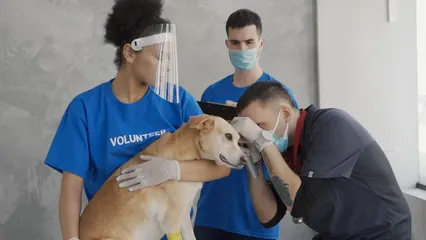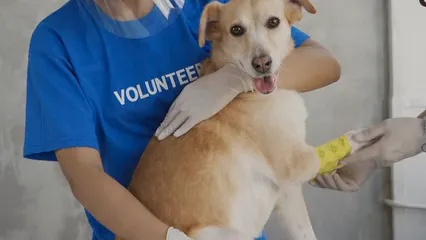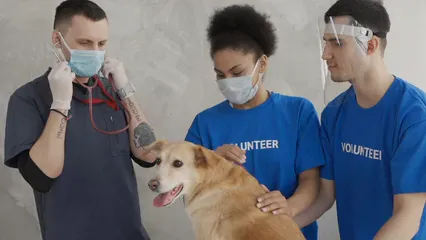When your dog is unwell, their entire body can be affected. This systemic response may cause weakness and reluctance to engage in daily activities. Treatment options vary based on the underlying issue. For infections, antibiotics are often prescribed. Autoimmune disorders may require immunosuppressive medications.
Regular veterinary check-ups and vaccinations play a crucial role in prevention. Keeping your dog protected from ticks and monitoring their health can help avoid these issues. If you notice any signs of infection, consult your veterinarian promptly for guidance. And speaking of prevention, don’t forget to stock up on Dog Waste Bags with Dispenser for those walks!

Neurological and Musculoskeletal Disorders
Neurological conditions can also lead to lameness in dogs. Intervertebral disc disease, for instance, affects the spinal cord and can cause pain and weakness. Nerve injuries may lead to coordination issues, resulting in limping.
Symptoms of these disorders include difficulty walking, dragging limbs, or abnormal postures. Diagnostic imaging, such as X-rays or MRIs, is essential for accurate diagnosis. These tools help veterinarians visualize the underlying issues affecting your dog.
Musculoskeletal disorders, including arthritis and ligament injuries, are prevalent as well. These conditions can occur due to age, overuse, or genetic predispositions. They often present with symptoms like stiffness after rest and reluctance to jump or play.
Both neurological and musculoskeletal issues require thorough evaluation. A veterinarian will assess your dog’s gait and examine affected limbs. Early detection can lead to more effective treatment options, such as medication or physical therapy. And if your pup is in need of some mental stimulation, consider a Outward Hound Hide-A-Squirrel Puzzle Toy to keep them engaged!

If your dog shows signs of ongoing lameness, seek a neurological assessment. Identifying the cause early can improve your dog’s quality of life and mobility.
Diagnosing Lameness in Dogs
Initial Veterinary Assessment
When you take your dog to the vet for lameness, expect a thorough evaluation. The veterinarian will start by asking about your dog’s history of lameness. They’ll want to know when it began and if any specific activities triggered it. This information is vital for understanding the issue.
Next, a physical examination will take place. The vet will observe how your dog walks, looking for signs of pain or discomfort. They will also palpate the affected limb, checking for swelling or tenderness. This process helps identify any abnormalities in bones, joints, or soft tissues.
Statistics show that around 30% of lameness cases require further diagnostic imaging, such as X-rays. These images can reveal hidden issues like fractures or joint problems. Keeping a record of your dog’s symptoms and any changes in behavior can be incredibly helpful for your vet. This information supports accurate diagnosis and effective treatment. And for those who want to keep their dog hydrated on the go, a Portable Pet Water Bottle is a must-have!

Diagnostic Imaging Techniques
Diagnostic imaging is crucial for pinpointing the cause of lameness. Various techniques are commonly used, including X-rays, CT scans, and MRIs. Each method provides unique insights into your dog’s condition.
X-rays are often the first step. They can identify fractures, joint problems, or signs of arthritis. CT scans offer a more detailed view of bones and soft tissues, while MRIs are excellent for assessing soft tissue injuries, such as ligament tears.
Success rates for diagnosing lameness through these imaging techniques are quite high. For instance, X-rays can accurately reveal issues in up to 90% of cases. Your veterinarian will decide on the most appropriate imaging based on your dog’s specific symptoms and needs.
If your dog is diagnosed with lameness, don’t hesitate to ask about the imaging options available. Understanding the cause is key to developing an effective treatment plan. And while you’re at it, consider investing in a Dog First Aid Kit to be prepared for any emergencies!

Treatment Options for Lameness
Medical Management
Managing pain and inflammation is crucial for dogs with lameness. Veterinarians often prescribe nonsteroidal anti-inflammatory drugs (NSAIDs) like carprofen or meloxicam. These medications can provide effective pain relief for dogs suffering from various conditions. Around 70% of dogs experience notable improvements when treated with these anti-inflammatory drugs.
In addition to NSAIDs, other pain management strategies may include opioids or gabapentin for severe cases. Dietary supplements are also beneficial. Glucosamine and chondroitin sulfate support joint health and help reduce discomfort. Omega-3 fatty acids are another great option for promoting joint function. Speaking of joint support, consider adding Zesty Paws Mobility Bites to their diet!
When considering pain relief for dogs, it’s essential to consult with a veterinarian. They can recommend appropriate medication options based on your dog’s specific needs and health conditions.

Physical Therapy and Rehabilitation
Physical therapy can work wonders for dogs experiencing lameness. It helps enhance mobility and strength while reducing pain. Common rehabilitation techniques include therapeutic exercises, hydrotherapy, and massage. These methods are designed to improve your dog’s overall physical condition.
Hydrotherapy is an effective rehabilitation method that can greatly benefit dogs with lameness. Hydrotherapy for dogs near me
Encouraging your dog to participate in rehabilitation can speed up recovery, especially after an injury. If your dog is dealing with lameness, consider exploring these rehabilitation options. They can significantly enhance your dog’s quality of life and overall well-being. Also, don’t forget to spoil them with a Dog Treats for Training to keep them motivated!

Please let us know what you think about our content by leaving a comment down below!
Thank you for reading till here 🙂
All images from Pexels
Common causes of lameness include injuries, joint diseases, and infections. Acute lameness may stem from injuries like fractures or sprains, while chronic lameness often results from conditions like osteoarthritis or hip dysplasia.
Understanding the implications of hip dysplasia is essential for managing your dog’s health effectively. Understanding and managing canine hip dysplasia
Veterinary assessment is essential for accurate diagnosis and effective treatment. The following sections will discuss symptoms, diagnostic methods, treatment options, and tips for home care. By understanding lameness, pet owners can better support their furry friends.

Causes of Lameness in Dogs
Common Injuries
Injuries are a leading cause of lameness in dogs. Many active dogs experience acute injuries like fractures, sprains, and torn ligaments. For instance, a fracture can occur from jumping or running, while sprains often result from sudden changes in direction.
Signs of injury are crucial to recognize. Look for swelling, heat, or redness in the affected limb. You might also notice your dog being reluctant to put weight on it or limping. These symptoms suggest your dog is in pain and needs attention.
Research shows that injury-related lameness is prevalent among active breeds. Approximately 30% of dogs involved in sports or regular vigorous activity experience some form of injury. Common locations for these injuries include the legs, paws, and joints.
As a pet owner, it’s vital to monitor your dog’s activity levels closely. If you notice any signs of injury, consult your veterinarian promptly to avoid further complications. And to keep your furry friend safe while swimming, consider a Paws Aboard Doggy Life Jacket.

Joint Diseases
Joint diseases can also lead to significant lameness in dogs. Conditions like osteoarthritis, hip dysplasia, and elbow dysplasia are common culprits. Osteoarthritis affects around 20% of older dogs, causing chronic pain and mobility issues.
Understanding joint diseases is critical for effective treatment and management of your dog’s mobility. Understanding and managing canine hip dysplasia
These conditions develop gradually, often due to wear and tear over time. Symptoms include stiffness after rest, difficulty rising, and reluctance to jump or play. Certain breeds are more predisposed to these conditions, such as large breeds for hip dysplasia.
Treatment options can vary. They may include medications to manage pain, physical therapy, or even surgery in severe cases. If you notice signs of joint pain in your dog, it’s essential to consult your veterinarian. Early intervention can significantly improve your dog’s quality of life. And to support their joint health, consider Dog Vitamins for Joint Health.

Infections and Diseases
Infections can significantly impact your dog’s mobility. Tick-borne diseases, like Lyme disease, are common culprits. Lyme disease affects approximately 2-5% of dogs in endemic areas. Signs of this infection include fever, lethargy, and joint swelling. You might also notice your dog exhibiting intermittent lameness, which can confuse pet owners.
Awareness of Lyme disease is important for early detection and treatment in dogs. Lyme disease in dogs
Autoimmune disorders are another source of lameness. Conditions such as autoimmune polyarthritis cause inflammation in the joints. This can lead to pain and difficulty moving. Both infections and autoimmune diseases can create systemic illness that manifests as lameness.
When your dog is unwell, their entire body can be affected. This systemic response may cause weakness and reluctance to engage in daily activities. Treatment options vary based on the underlying issue. For infections, antibiotics are often prescribed. Autoimmune disorders may require immunosuppressive medications.
Regular veterinary check-ups and vaccinations play a crucial role in prevention. Keeping your dog protected from ticks and monitoring their health can help avoid these issues. If you notice any signs of infection, consult your veterinarian promptly for guidance. And speaking of prevention, don’t forget to stock up on Dog Waste Bags with Dispenser for those walks!

Neurological and Musculoskeletal Disorders
Neurological conditions can also lead to lameness in dogs. Intervertebral disc disease, for instance, affects the spinal cord and can cause pain and weakness. Nerve injuries may lead to coordination issues, resulting in limping.
Symptoms of these disorders include difficulty walking, dragging limbs, or abnormal postures. Diagnostic imaging, such as X-rays or MRIs, is essential for accurate diagnosis. These tools help veterinarians visualize the underlying issues affecting your dog.
Musculoskeletal disorders, including arthritis and ligament injuries, are prevalent as well. These conditions can occur due to age, overuse, or genetic predispositions. They often present with symptoms like stiffness after rest and reluctance to jump or play.
Both neurological and musculoskeletal issues require thorough evaluation. A veterinarian will assess your dog’s gait and examine affected limbs. Early detection can lead to more effective treatment options, such as medication or physical therapy. And if your pup is in need of some mental stimulation, consider a Outward Hound Hide-A-Squirrel Puzzle Toy to keep them engaged!

If your dog shows signs of ongoing lameness, seek a neurological assessment. Identifying the cause early can improve your dog’s quality of life and mobility.
Diagnosing Lameness in Dogs
Initial Veterinary Assessment
When you take your dog to the vet for lameness, expect a thorough evaluation. The veterinarian will start by asking about your dog’s history of lameness. They’ll want to know when it began and if any specific activities triggered it. This information is vital for understanding the issue.
Next, a physical examination will take place. The vet will observe how your dog walks, looking for signs of pain or discomfort. They will also palpate the affected limb, checking for swelling or tenderness. This process helps identify any abnormalities in bones, joints, or soft tissues.
Statistics show that around 30% of lameness cases require further diagnostic imaging, such as X-rays. These images can reveal hidden issues like fractures or joint problems. Keeping a record of your dog’s symptoms and any changes in behavior can be incredibly helpful for your vet. This information supports accurate diagnosis and effective treatment. And for those who want to keep their dog hydrated on the go, a Portable Pet Water Bottle is a must-have!

Diagnostic Imaging Techniques
Diagnostic imaging is crucial for pinpointing the cause of lameness. Various techniques are commonly used, including X-rays, CT scans, and MRIs. Each method provides unique insights into your dog’s condition.
X-rays are often the first step. They can identify fractures, joint problems, or signs of arthritis. CT scans offer a more detailed view of bones and soft tissues, while MRIs are excellent for assessing soft tissue injuries, such as ligament tears.
Success rates for diagnosing lameness through these imaging techniques are quite high. For instance, X-rays can accurately reveal issues in up to 90% of cases. Your veterinarian will decide on the most appropriate imaging based on your dog’s specific symptoms and needs.
If your dog is diagnosed with lameness, don’t hesitate to ask about the imaging options available. Understanding the cause is key to developing an effective treatment plan. And while you’re at it, consider investing in a Dog First Aid Kit to be prepared for any emergencies!

Treatment Options for Lameness
Medical Management
Managing pain and inflammation is crucial for dogs with lameness. Veterinarians often prescribe nonsteroidal anti-inflammatory drugs (NSAIDs) like carprofen or meloxicam. These medications can provide effective pain relief for dogs suffering from various conditions. Around 70% of dogs experience notable improvements when treated with these anti-inflammatory drugs.
In addition to NSAIDs, other pain management strategies may include opioids or gabapentin for severe cases. Dietary supplements are also beneficial. Glucosamine and chondroitin sulfate support joint health and help reduce discomfort. Omega-3 fatty acids are another great option for promoting joint function. Speaking of joint support, consider adding Zesty Paws Mobility Bites to their diet!
When considering pain relief for dogs, it’s essential to consult with a veterinarian. They can recommend appropriate medication options based on your dog’s specific needs and health conditions.

Physical Therapy and Rehabilitation
Physical therapy can work wonders for dogs experiencing lameness. It helps enhance mobility and strength while reducing pain. Common rehabilitation techniques include therapeutic exercises, hydrotherapy, and massage. These methods are designed to improve your dog’s overall physical condition.
Hydrotherapy is an effective rehabilitation method that can greatly benefit dogs with lameness. Hydrotherapy for dogs near me
Encouraging your dog to participate in rehabilitation can speed up recovery, especially after an injury. If your dog is dealing with lameness, consider exploring these rehabilitation options. They can significantly enhance your dog’s quality of life and overall well-being. Also, don’t forget to spoil them with a Dog Treats for Training to keep them motivated!

Please let us know what you think about our content by leaving a comment down below!
Thank you for reading till here 🙂
All images from Pexels
Introduction
Lameness in dogs is a significant concern for pet owners. It often signals underlying health issues that require attention. Recognizing lameness is crucial for your dog’s well-being. Quick veterinary care can help avoid further complications. This article serves as a guide to understand lameness in dogs, covering its causes, diagnosis, and treatment options.
While you’re at it, why not pamper your pup with a PetFusion Ultimate Dog Bed? A cozy place to rest can work wonders for their recovery!

Summary and Overview
Lameness, or limping, refers to a dog’s inability to use its limbs properly. This condition can severely impact mobility and overall quality of life. Lameness can be classified as either acute, which comes on suddenly, or chronic, which persists over time.
Common causes of lameness include injuries, joint diseases, and infections. Acute lameness may stem from injuries like fractures or sprains, while chronic lameness often results from conditions like osteoarthritis or hip dysplasia.
Understanding the implications of hip dysplasia is essential for managing your dog’s health effectively. Understanding and managing canine hip dysplasia
Veterinary assessment is essential for accurate diagnosis and effective treatment. The following sections will discuss symptoms, diagnostic methods, treatment options, and tips for home care. By understanding lameness, pet owners can better support their furry friends.

Causes of Lameness in Dogs
Common Injuries
Injuries are a leading cause of lameness in dogs. Many active dogs experience acute injuries like fractures, sprains, and torn ligaments. For instance, a fracture can occur from jumping or running, while sprains often result from sudden changes in direction.
Signs of injury are crucial to recognize. Look for swelling, heat, or redness in the affected limb. You might also notice your dog being reluctant to put weight on it or limping. These symptoms suggest your dog is in pain and needs attention.
Research shows that injury-related lameness is prevalent among active breeds. Approximately 30% of dogs involved in sports or regular vigorous activity experience some form of injury. Common locations for these injuries include the legs, paws, and joints.
As a pet owner, it’s vital to monitor your dog’s activity levels closely. If you notice any signs of injury, consult your veterinarian promptly to avoid further complications. And to keep your furry friend safe while swimming, consider a Paws Aboard Doggy Life Jacket.

Joint Diseases
Joint diseases can also lead to significant lameness in dogs. Conditions like osteoarthritis, hip dysplasia, and elbow dysplasia are common culprits. Osteoarthritis affects around 20% of older dogs, causing chronic pain and mobility issues.
Understanding joint diseases is critical for effective treatment and management of your dog’s mobility. Understanding and managing canine hip dysplasia
These conditions develop gradually, often due to wear and tear over time. Symptoms include stiffness after rest, difficulty rising, and reluctance to jump or play. Certain breeds are more predisposed to these conditions, such as large breeds for hip dysplasia.
Treatment options can vary. They may include medications to manage pain, physical therapy, or even surgery in severe cases. If you notice signs of joint pain in your dog, it’s essential to consult your veterinarian. Early intervention can significantly improve your dog’s quality of life. And to support their joint health, consider Dog Vitamins for Joint Health.

Infections and Diseases
Infections can significantly impact your dog’s mobility. Tick-borne diseases, like Lyme disease, are common culprits. Lyme disease affects approximately 2-5% of dogs in endemic areas. Signs of this infection include fever, lethargy, and joint swelling. You might also notice your dog exhibiting intermittent lameness, which can confuse pet owners.
Awareness of Lyme disease is important for early detection and treatment in dogs. Lyme disease in dogs
Autoimmune disorders are another source of lameness. Conditions such as autoimmune polyarthritis cause inflammation in the joints. This can lead to pain and difficulty moving. Both infections and autoimmune diseases can create systemic illness that manifests as lameness.
When your dog is unwell, their entire body can be affected. This systemic response may cause weakness and reluctance to engage in daily activities. Treatment options vary based on the underlying issue. For infections, antibiotics are often prescribed. Autoimmune disorders may require immunosuppressive medications.
Regular veterinary check-ups and vaccinations play a crucial role in prevention. Keeping your dog protected from ticks and monitoring their health can help avoid these issues. If you notice any signs of infection, consult your veterinarian promptly for guidance. And speaking of prevention, don’t forget to stock up on Dog Waste Bags with Dispenser for those walks!

Neurological and Musculoskeletal Disorders
Neurological conditions can also lead to lameness in dogs. Intervertebral disc disease, for instance, affects the spinal cord and can cause pain and weakness. Nerve injuries may lead to coordination issues, resulting in limping.
Symptoms of these disorders include difficulty walking, dragging limbs, or abnormal postures. Diagnostic imaging, such as X-rays or MRIs, is essential for accurate diagnosis. These tools help veterinarians visualize the underlying issues affecting your dog.
Musculoskeletal disorders, including arthritis and ligament injuries, are prevalent as well. These conditions can occur due to age, overuse, or genetic predispositions. They often present with symptoms like stiffness after rest and reluctance to jump or play.
Both neurological and musculoskeletal issues require thorough evaluation. A veterinarian will assess your dog’s gait and examine affected limbs. Early detection can lead to more effective treatment options, such as medication or physical therapy. And if your pup is in need of some mental stimulation, consider a Outward Hound Hide-A-Squirrel Puzzle Toy to keep them engaged!

If your dog shows signs of ongoing lameness, seek a neurological assessment. Identifying the cause early can improve your dog’s quality of life and mobility.
Diagnosing Lameness in Dogs
Initial Veterinary Assessment
When you take your dog to the vet for lameness, expect a thorough evaluation. The veterinarian will start by asking about your dog’s history of lameness. They’ll want to know when it began and if any specific activities triggered it. This information is vital for understanding the issue.
Next, a physical examination will take place. The vet will observe how your dog walks, looking for signs of pain or discomfort. They will also palpate the affected limb, checking for swelling or tenderness. This process helps identify any abnormalities in bones, joints, or soft tissues.
Statistics show that around 30% of lameness cases require further diagnostic imaging, such as X-rays. These images can reveal hidden issues like fractures or joint problems. Keeping a record of your dog’s symptoms and any changes in behavior can be incredibly helpful for your vet. This information supports accurate diagnosis and effective treatment. And for those who want to keep their dog hydrated on the go, a Portable Pet Water Bottle is a must-have!

Diagnostic Imaging Techniques
Diagnostic imaging is crucial for pinpointing the cause of lameness. Various techniques are commonly used, including X-rays, CT scans, and MRIs. Each method provides unique insights into your dog’s condition.
X-rays are often the first step. They can identify fractures, joint problems, or signs of arthritis. CT scans offer a more detailed view of bones and soft tissues, while MRIs are excellent for assessing soft tissue injuries, such as ligament tears.
Success rates for diagnosing lameness through these imaging techniques are quite high. For instance, X-rays can accurately reveal issues in up to 90% of cases. Your veterinarian will decide on the most appropriate imaging based on your dog’s specific symptoms and needs.
If your dog is diagnosed with lameness, don’t hesitate to ask about the imaging options available. Understanding the cause is key to developing an effective treatment plan. And while you’re at it, consider investing in a Dog First Aid Kit to be prepared for any emergencies!

Treatment Options for Lameness
Medical Management
Managing pain and inflammation is crucial for dogs with lameness. Veterinarians often prescribe nonsteroidal anti-inflammatory drugs (NSAIDs) like carprofen or meloxicam. These medications can provide effective pain relief for dogs suffering from various conditions. Around 70% of dogs experience notable improvements when treated with these anti-inflammatory drugs.
In addition to NSAIDs, other pain management strategies may include opioids or gabapentin for severe cases. Dietary supplements are also beneficial. Glucosamine and chondroitin sulfate support joint health and help reduce discomfort. Omega-3 fatty acids are another great option for promoting joint function. Speaking of joint support, consider adding Zesty Paws Mobility Bites to their diet!
When considering pain relief for dogs, it’s essential to consult with a veterinarian. They can recommend appropriate medication options based on your dog’s specific needs and health conditions.

Physical Therapy and Rehabilitation
Physical therapy can work wonders for dogs experiencing lameness. It helps enhance mobility and strength while reducing pain. Common rehabilitation techniques include therapeutic exercises, hydrotherapy, and massage. These methods are designed to improve your dog’s overall physical condition.
Hydrotherapy is an effective rehabilitation method that can greatly benefit dogs with lameness. Hydrotherapy for dogs near me
Encouraging your dog to participate in rehabilitation can speed up recovery, especially after an injury. If your dog is dealing with lameness, consider exploring these rehabilitation options. They can significantly enhance your dog’s quality of life and overall well-being. Also, don’t forget to spoil them with a Dog Treats for Training to keep them motivated!

Please let us know what you think about our content by leaving a comment down below!
Thank you for reading till here 🙂
All images from Pexels





